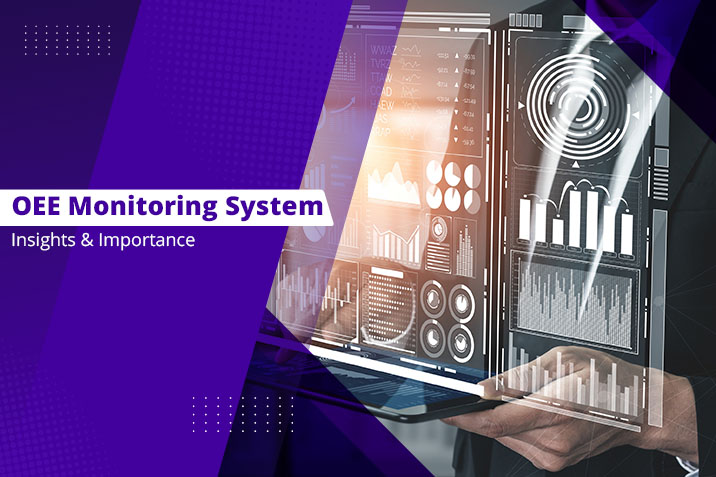OEE is one of the most important performance measurements in modern manufacturing facilities. By optimising OEE, you can increase capacity, reduce costs, improve quality, and/or increase efficiencies. It is calculated as the ratio of actual vs. potential output or efficiency. In other words, it is the ratio of final output to total input. OEE Monitoring Systems allow you to calculate the actual output of the process in terms of units produced or per unit of input. If OEE is high, we can infer that the process is doing well.
The number of enterprises who count on analytics and Business Intelligence (BI) to improve manufacturing productivity and quality is growing.
IOT plays an important role in OEE Monitoring System in the form of BI. Advances in business intelligence systems enable to create and generate reports and to analyse data to improve production efficiency. Assessing asset utilization, productivity, and quality provides manufacturers with the data they need to keep production plants operating.
Why Is OEE Important?

OEE monitoring system is not a single metric, but is the sum of several metrics, including the total time, cost and the effectiveness of each tool in a project. It is used to monitor costs, process, quality, and other project metrics. It has shown to be an important metric, because it can help to identify, and correct for, the problems in a project.
In short, it is important that all equipment be effective within your manufacturing unit. In the long run, OEE is a good indication of the overall well-being of a system.
An OEE score of 85% is currently regarded extraordinary. The reality is that many production facilities fall far short of this standard, allowing for major improvements. However, achieving a 100% score on your OEE Monitoring System is critical to identify and implement strategies to improve process efficiency. The use of IOT can help improve this situation by providing valuable data and information.
Benefits Of Using OEE Monitoring System For Your Business
- • Ensures that existing equipment is used to its greatest potential, eliminating the need for additional expenditure in other areas.
- • Gives you a clearer view of the manufacturing process, so you know where the real issues are and how to prioritize them.
- • Provides a strong return on investment whether you are boosting capacity, driving efficiencies, introducing new goods, or doing anything else.
- • Aids in maintaining market competitiveness, particularly in competitive industries such as pharmaceutical and medical device manufacture.
- • Enhanced process integrity will save you money and effort while also assisting you in maintaining your market reputation and avoiding the risks and consequences of product recalls.
- • Reduces machine maintenance and repair expenses because correct plans and schedules can be implemented.
- • Increases the scalability of your manufacturing line.
Challenges In Implementing OEE Monitoring System For Your Manufacturing Unit
Availability- refers to planned production stops for setups and modifications such as planned maintenance, cleaning, and quality checks. Unplanned stops do occur for a variety of causes, including clogged sensors, misfeeds, and jams. These unplanned stops affect OEE – they cause loss of efficiency of setup, and of planned maintenance time, both of which cause loss in OEE.
Performance – may be hindered when the production is not run at full capacity. Production may require stoppage due to machine breakdown or unexpected equipment failure. It can be difficult to identify trends of equipment failures when they exist in low numbers, such as in a manufacturing line. OEE is an important factor for assessing the efficiency of equipment within a plant.
Quality – Issues caused by defective items, as well as yield losses as a result of defective products. Operator mistake, incorrect settings, and poor batch changeover operations are a few examples. All of these incidents reduce the overall efficacy of the production line’s equipment.
To Summarize
Every unit should have an OEE monitoring system in place to evaluate product quality and production line performance. To do this, IOT relies on two independent components, data storage and quality assessment functions, to collect data from the OEE monitoring system.
An OEE Monitoring system based on IoT, or the Internet of Things, collects data from physical sensors located across a manufacturing line. Sensor data is collected and transferred to a data warehouse, where it is analyzed by AI or other algorithms.
OEE includes several aspects such as reliability of operation, maintenance-ability, operational effectiveness, availability of spare parts, and the like. IOT, as part of OEE Monitoring System, brings in efficiency, precision and easiness of implementation. It can also be more effective due to its compactness and cost effectiveness.
The major benefit of IOT is that the data collected is immediately processed and made available. It shall be integrated into the control of the equipment to collect, collate and transmit data. With the help of IOT, operators can take smart decisions, and the equipment can be operated with enhanced efficiency, safety and quality.
We at Future Algos, collaborate and build IOT solutions for manufacturing units to setup an efficient OEE Monitoring System. We have experience in building IOT Monitoring solutions for manufacturing units for various industries and in various countries. Call us or email us to collaborate with our team and build end to end, customized IOT solutions, for your manufacturing units.




